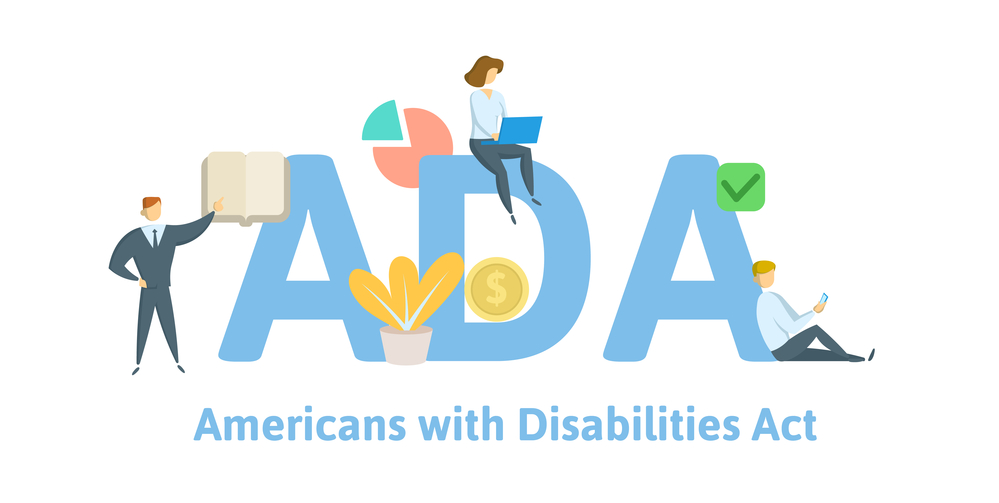ADA Website Compliance. What you need to know.
- December 30, 2020
- Posted by: TOLS Multimedia
- Category: Web Design

With the increasing digitalization of the world, almost everyone has access to the resources and information on the Internet. However, it is vital to remember that not all users are the same, and there people with disabilities who require special aid in order to experience the wonders of the digital age.
As more and more people access the Internet, the onus falls on organizations and entities to ensure that their websites are accessible to all. The World Wide Web Consortium’s Web Content Accessibility Guidelines (WCAG) have helped push the movement forward, however, there is also a growing movement to make organizations comply with the United States’ Americans with Disabilities Act (ADA) regulations as well.
The Americans with Disabilities Act is more commonly used when in the physical world, such as implementing wheelchair accessibility or the use of Braille for the visually impaired. That does not mean it has no bearing in the digital space. Web content should be accessible to everyone.
If you are not clear on the requirements of the ADA website compliance, read on.
What is ADA Website Compliance?
The Americans with Disabilities Act was first instituted in 1990 as a means to end discrimination based on someone’s ability. While it mandates that organizations make suitable accommodations for those differently able, the act does not necessarily specify how that translates when it comes to websites.
Even with several amendments made in 2008 to cover more of web-based content, there is still no clear guideline that oversees everything. If there is a cause for dispute, it usually falls to the courts to decide if a website is complying with the ADA.
However, there are certainly past examples to draw from when it comes to understanding the ADA for websites. Commercial and e-commerce websites are those likely to experience dispute when it comes to being accessible, after all, if there is money involved, being aware of everything is the best way forward.
To understand ADA website compliance, it is best to refer to the WCAG. The latest WCAG 2.1 guidelines can guide organizations in creating websites that are likely to be compliant with the ADA.
Is ADA Website Compliance Absolutely Compulsory?
The truth is, complying with the ADA is not a mandatory step that every institution and organization needs to take. This is especially so when there is no proper structure and guidelines in place to govern the entire process, much less enforce it.
Certain businesses and organizations are required to comply with the ADA. State and local governments, private businesses, nonprofits, and charities with more than 15 employees, and any company that the public access regularly fall under this particular area. Hotels, travel agencies, as well as healthcare, educational, and financial institutions are also under increasing scrutiny when it comes to compliance.
That being said, catering to all your users is always a much preferred direction to take. It not only gives you more of an audience, but you can also be sure that users will be more appreciative of the efforts made. There is no need to take a gamble when it comes to complying with the ADA and risk leaving your organization open to an accessibility lawsuit.
Main Accessibility Guidelines
Based on the WCAG 2.1 guidelines, there are some distinct areas that need to be covered to ensure your website is accessible to all. Forming the easily remembered acronym P.O.U.R, here are the different areas you need to look at:
- Perceivable: Content must be easily perceivable to users, as well as easy to process. This can include providing alternatives to text, such as the use of audio supplements and assistive technology.
- Operable: Navigating and usage within the website has to be a smooth process regardless of your ability. This can be in the form of keyboard shortcuts or making your website entirely operable with just keyboard commands to cater to those who have difficulty with using a mouse.
- Understandable: The website’s content must be easily comprehended and differentiated. Input assistance falls under this category, while clear explanations must be implemented in all scenarios.
- Robust: Making sure your website keeps up to date with the latest devices and platforms, and is able to evolve and change to fit the changing needs of those who need it.
More specifically, these guidelines can help ensure your website is accessible to all:
Content
Whether it’s visual, auditory, motor, or cognitive, these disabilities should be covered with your content. Proper use of headings can help those with visual impairments consume your content easily, while a logical sequence will help as well.
Keepings sentences short and precise is also key, while the use of lists, summaries, and bolded keywords are helpful as well. Avoid jargon whenever possible.
Descriptive link text should be used when links are involved, and all files should be accessible.
Design
Making your website more usable for everyone is always a good step. This can apply to the different content used. Videos should have subtitles, while descriptive text and audio transcripts can help some of us understand the content better.
Provide alt text for images to help text readers know what the image is about. Font choice and size should be standardized to minimize distractions. Colors are essential, so provide sufficient contrast, or patterns, fill, sizing, borders, icons, or whitespace as additions.
Website Accessibility
Website accessibility is an important element, so consider the following measures. Keyboard navigation will help those with motor and visual disabilities, and visual indicators will enhance their experience as well.
Labels for forms and tables will make things easier to understand, especially for screen readers. Ensuring said forms and tables are easy to use and logical is also key.
Lastly, all call-to-action buttons should be made accessible with proper labelling.
How Do I Make My Website ADA Compliant?
To follow ADA website compliance, the World Wide Web Consortium (W3C) established the Web Content Accessibility Guidelines (WCAG). The WCAG essentially stated that to be accessible, a website has to be (1) perceivable, (2) operable, (3) understandable, and (4) robust.
Perceivable
Being perceivable means that information from the website should be accessible to the website visitor. There are many ways to help make a website more perceivable.
One easy way is to add descriptive text to all images. People with visual impairments might not be able to see images the same way everyone else does. Adding descriptive text levels the playing field, allowing all users to have the same amount of information. Adding descriptive text also allows blind people to receive the information in the images by having the descriptive text read aloud by text-to-speech software.
Being able to change the size of the text without breaking the page layout or structure also helps a website be more perceivable. Some users might have difficulty with the default text size and would prefer the option to enlarge the text for better visibility.
Operable
An operable website is one that can be navigated by any user, regardless of ability. There are several ways a website can be designed to be more operable.
The first way would be to design a website that can be navigated with a keyboard alone. The typical computer would have two forms of input: the keyboard and the mouse. Making a website navigable with just a keyboard would make your website accessible to certain people.
One of the most important things in making a website operable is by designing it in a way that makes it easy to navigate. This is often tested when websites are being developed – how fast it would take a regular visitor to find a specific piece of information. Design elements that make websites easy to navigate include clearly marked headers, descriptive titles, and intuitive hyperlinks.
One thing to avoid in making websites is having moving banners as a source of information. If you must have a moving banner, make sure that it moves slowly so that it would give visitors enough time to be able to read the text written on it.
Understandable
Making a website understandable might be a little trickier because it really depends on the user experience. An understandable website is one that a user can intuitively use and navigate. Websites that are understandable use layouts that people are already familiar with and would have an idea how to approach.
A little assistance for visitors will always be appreciated towards being understandable. These assistants can be in the form of search bars, instructions, and useful validation errors.
Robust
A robust website is technologically heavy because this just means that your website will work as you intend it to in all formats. This means that your website should look and behave the same across different browsers, different operating systems, and different devices. A robust website makes it accessible across a broader audience, making it ADA compliant.
Should I Be Concerned?
Well, it depends. Not all websites have to follow ADA compliance. The only ones required to follow ADA compliance are:
- State and local governments
- Private businesses with more than 15 employees
- Nonprofits and charities with more than 15 employees
- Companies relying on the public or that benefit the public
If your website does not fall under these requirements, then you have nothing to worry about. However, if it so happens that your website does fall under the requirements listed above, then there are some things you should be concerned about.
The biggest risk with not following ADA guidelines would be getting sued for not being ADA compliant. This is very serious and happens all the time. It is said that on the Federal level, a lawsuit is filed every hour against businesses whose web services are not ADA compliant. These lawsuits can really hit companies financially. An example would be when the American retail store Target was sued for not following ADA guidelines in their web services – a lawsuit that cost them a total of $10 million in fees and remediation to settle.
Aside from the financial setback, being sued for not complying with ADA guidelines will also hurt your website and company’s branding. Especially for larger corporations, a website that is not ADA compliant is a statement to the world that they are being ableist and do not care about people with disabilities.
Benefits of ADA Website Compliance
There are several benefits for websites that follow ADA website accessibility guidelines. The first benefit would be a larger audience for your compliant ADA website. Estimates say that in the US population alone, almost 20% would have a certain disability. Making your website comply with the ADA means that you won’t be turning away any potential visitors.
Aside from getting more visitors, having ADA compliance would build your website’s reputation. Complying with the ADA tells the world that you are inclusive and consider the conditions of those around them. This will become good branding that will become highly beneficial down the road.
Related Content >> What is Agile Software Development?
Conclusion
ADA compliance is a small step to take for fair and equal access to all people. While it may only be required for some websites, when you make your website accessible and follow the guidelines, you not only make the effort to include people with disabilities but you also reap other benefits along the way.
If you need more web design guidance to ensure your website’s ADA compliance, contact TOLS Multimedia for a consultation.
